Would you like to improve the performance of your search campaigns?
We’ve been able to show CPC decreases of 30% and conversion volume increases of 27% using a new recipe. Keep reading to find out how.
When it comes to Google Ads, machine learning and automation are the future. Because of that, we’re big fans of smart bidding here at KlientBoost.
BUT, as more and more advertisers are adopting smart bidding strategies and giving more control within the campaign back to Google, how can we keep a leg up on the competition and give our campaigns the best chance of success in competitive auctions?
In this post we’ll be uncovering how using portfolio bid strategies (or hybrid bidding) with smart bidding (particularly Target CPA) in search campaigns can help unlock an extra level of control that isn’t natively available at the campaign level - max CPC bid limits.
- Before & After
- Automated (smart) bidding and why it’s important
- What Is Target CPA?
- What Are Portfolio Bid Strategies & Why Are They Important?
- Put Them Together And What Do You Get?
- The Setup
- Calculating and setting your Max CPC Bid Limits
- Structuring Your Campaigns For Success
- Who Should Use This Strategy?
- Who Shouldn’t Use This Strategy?
- Key Takeaways
Get brand new Google ad strategies straight to your inbox every week. 23,739 people already are!
Before & After
Before diving into how you can implement this strategy yourself, here’s a quick before and after breakdown of campaign performance utilizing the max CPC thresholds within the portfolio bid strategy (Target CPA) vs. utilizing Target CPA bidding strategy on its own at the campaign level:
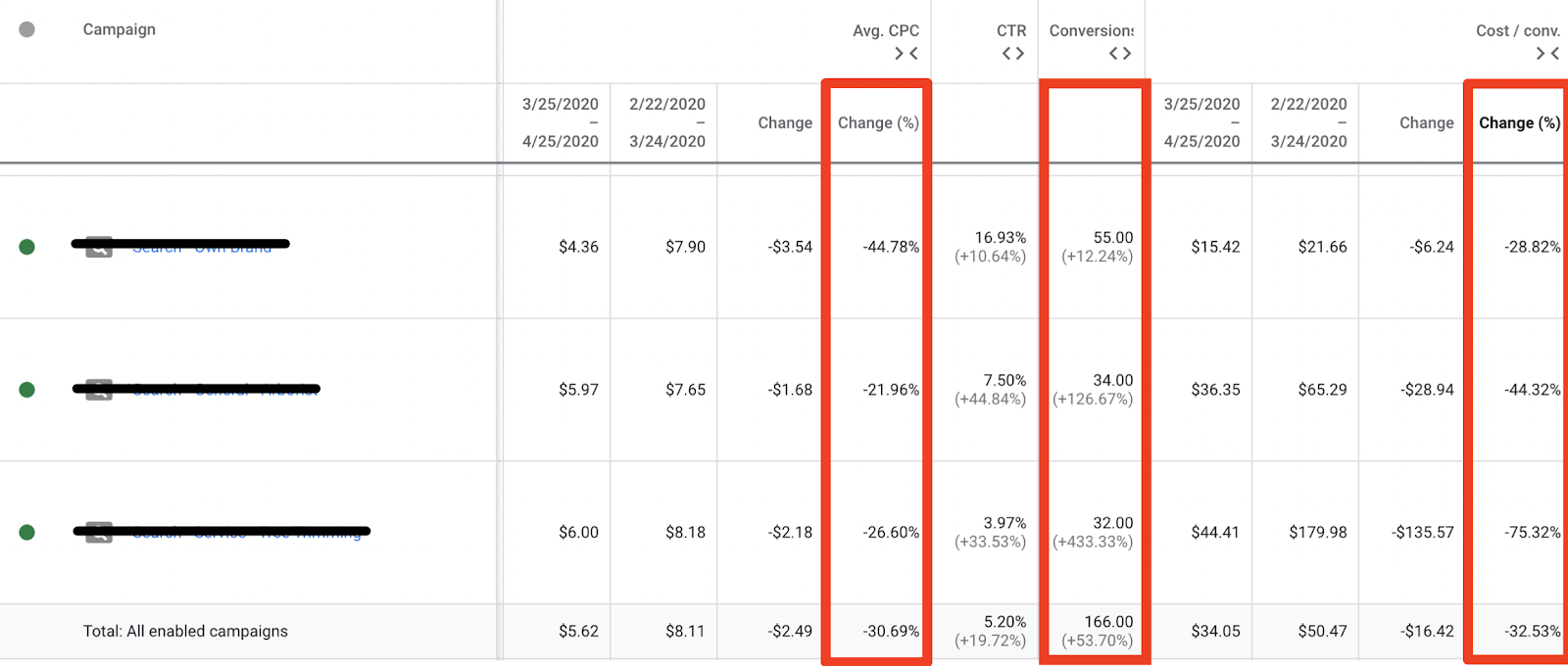




Now that I’ve got your attention, let’s dive into the different elements of this strategy and how to get it implemented into your digital marketing portfolio.
Automated (smart) bidding and why it’s important
Google defines automated bidding as:
Automated bidding takes the heavy lifting and guesswork out of setting bids to meet your performance goals. Each type of automated bid strategy is designed to help you achieve a specific goal for your business.
If you’d like to learn about all the different smart bidding strategies, you can check them out here.
Today we’ll be focusing on Target CPA in particular.
What Is Target CPA?
For those of you that aren’t familiar with Target CPA:
Target CPA is a Google Ads Smart Bidding strategy that sets bids to help get as many conversions as possible at or below the target cost-per-action (CPA) you set. It uses advanced machine learning to automatically optimize bids and offers auction-time bidding capabilities that tailor bids for each and every auction.
Target CPA is available as either a standard strategy in a single campaign or as a portfolio strategy across multiple campaigns. It enables advertisers to leverage Google’s machine learning algorithm to make real-time bid adjustments to get your ad in front of the user with the right user intent at the right time.
While manual-bidding (manual CPC & enhanced CPC) campaigns treat all clicks for a given keyword equally, Target CPA campaigns leverage Google’s vast database of user behavior to sift through the murky water of available impressions and find the “golden nugget” users with high intent to convert on their offer.
Because manual bidding doesn’t utilize the machine learning algorithm when entering different auctions, it puts the advertiser at a disadvantage when competing with those who are leveraging automated bidding to consider a myriad of factors and make dynamic bid adjustments on the fly 24/7.
Target CPA is one of the most popular automated bidding strategies among advertisers because it ensures some stability as they increase spend and expand to more keyword niches.
What Are Portfolio Bid Strategies & Why Are They Important?
Now that we know a little more about what Target CPA can do on its own, let’s talk more about what portfolio bid strategies are and why they’re an important piece to the puzzle.
“An automated, goal-driven bid strategy that groups together multiple campaigns, ad groups, and keywords. Portfolio bid strategies automatically set bids to help you reach your performance goals. They include the following Smart bidding strategies: Target CPA, Target ROAS, Maximize conversions, Maximize conversion value, Maximize clicks, and Target impression share.
Once you create a portfolio strategy, it will be stored in your Shared Library. This is the central location for managing your portfolio bid strategies and tracking their performance.
There are two main benefits to implementing portfolio bid strategies:
- They can improve the speed of optimizations within a group of campaigns by combining the learnings of all campaigns under the same roof (faster learning period = faster rate of optimization)
- They unlock an option for us to layer Max CPC bid limits ON TOP OF Target CPA campaigns and provide an extra layer of control that most advertisers aren’t currently taking advantage of
Put Them Together And What Do You Get?
When portfolio bid strategies are layered on top of target CPA campaigns, a new option becomes available under the Target CPA goal in the “Advanced Options” dropdown.
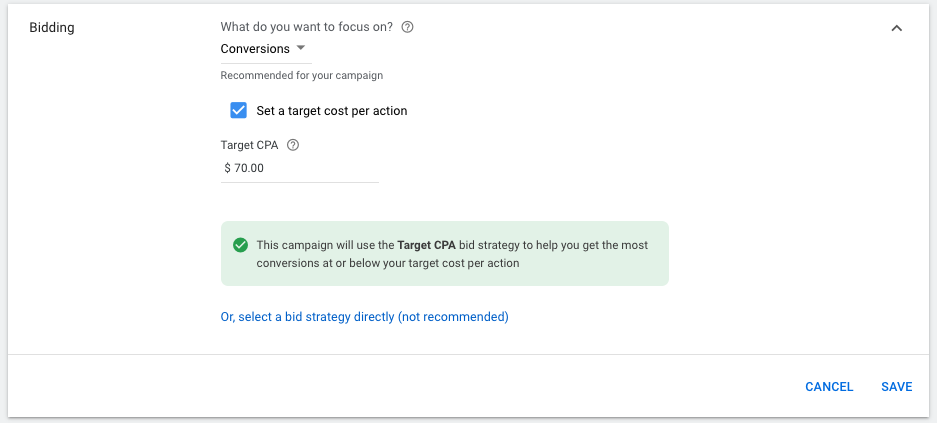
Target CPA at the portfolio bid strategy level (with max CPC bid limit options)
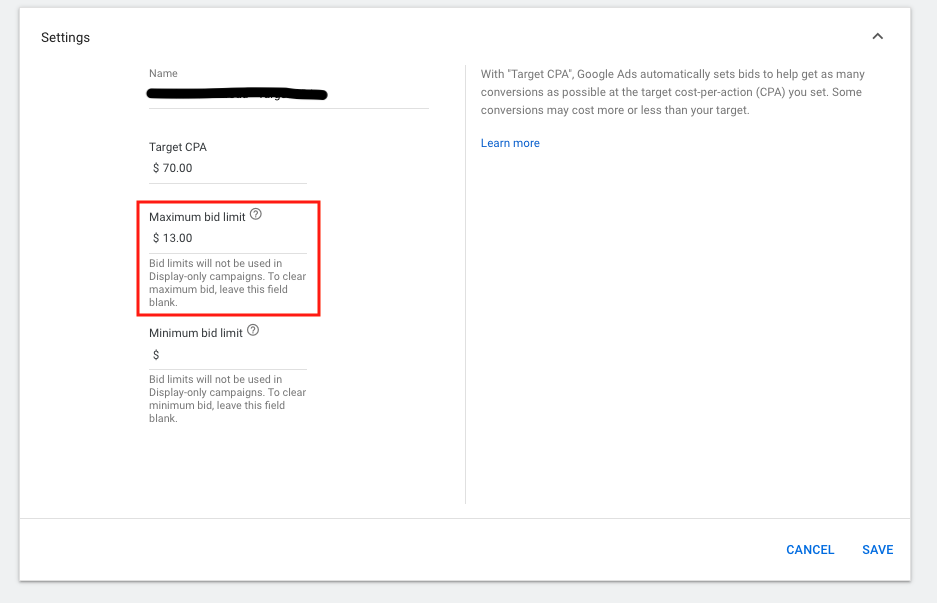
Why is this important? Because setting a max CPC bid limit can give Google an extra rule to consider when deciding which auctions to bid on with your daily budget. Instead of telling Google “I want to pay $70 or less for a lead” I can now tell Google “I want to pay $70 or less for a lead AND I’m not willing to pay more than $13 for any one click along the way”.
The Setup
Now that we’ve covered the basics, let’s go through an example of setting this type of campaign up:
Choose the campaign you’d like to begin working with:

Step 2: Create a portfolio bid strategy that we can layer on top of this campaign (here’s Google’s guide to setting a portfolio bid strategy):
Navigate to “Tools & Settings” and select “Bid strategies”

Once on the “Bid strategies” menu, click the + button to open up a dropdown menu:
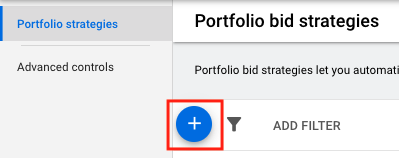
From here, we’ll want to select Target CPA
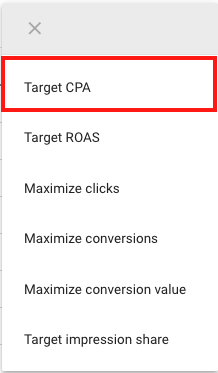
A new page will appear asking you to create a name and Target CPA goal for this new portfolio bid strategy. Use your best judgment when selecting your Target CPA goal (Google is recommending that I use a starting Target CPA goal of $91.79 for this particular campaign).
Unlike traditional Target CPA campaigns where your only option is to set a Target CPA goal, this new campaign with the portfolio bid strategy layered on top will unlock an “advanced options” section where we’ll be able to give Google additional rules to follow as they bid on different auctions.
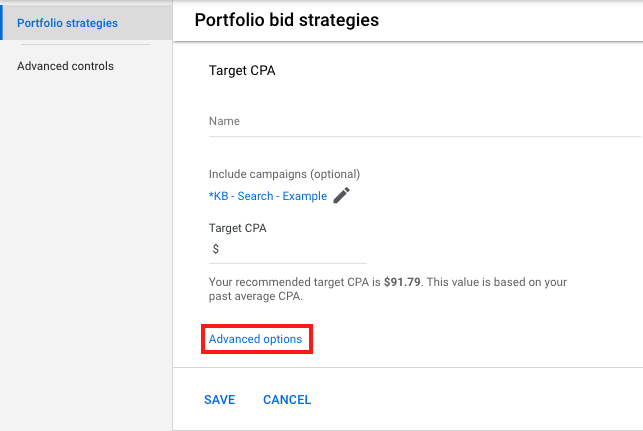
Once the “Advanced options” box is clicked, your page should look like this with the option to set a “Maximum bid limit”:
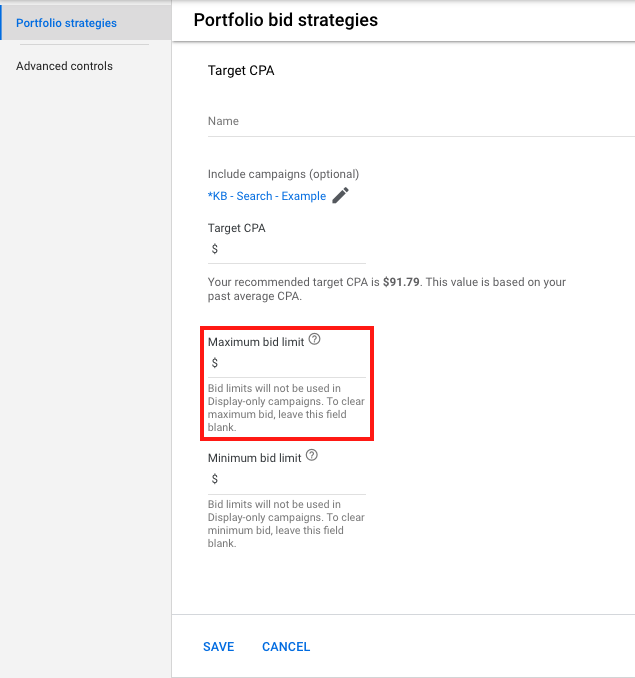
Calculating and setting your Max CPC Bid Limits
Deciding where to set as your max CPC bid limit for the campaign is a crucial piece to having success with this strategy.
Let’s use this campaign again as an example:

As a rule of thumb, we like to start out introducing this strategy by setting the max CPC bid limit to be 25% higher than the average CPC. This means that our example campaign with an average CPC of $17.09 would need a max CPC bid limit of $21.36.
$17.09 x 1.25 = $21.36
You’ll be able to turn this max CPC threshold up or down once you get a new baseline of results. You’ll use your average CPA, CPC, search top IS stats & the portfolio bid strategy recommendations to determine if you should increase or decrease that max CPC bid limit:

Structuring Your Campaigns For Success
When mapping out and implementing this strategy, there are a few things you’ll want to consider:
Grouping keywords into campaigns by similar average CPCs:
Because we’ll be setting max CPC bid limitations on these campaigns, it’s important to have keywords grouped by similar average CPCs. That way we can set unique max CPC bid limits for each group and ensure we don’t unintentionally cut off traffic to a more expensive keyword bid bucketed with cheaper keyword bids.
Example:
If keyword group A has an average CPC of $2 and keyword group B has an average CPC of $7 then we’d want to create separate campaigns for each keyword group to account for the wide disparity in CPC and maximize the potential of both groups.
If we set the max CPC at $3 then keyword group B wouldn’t serve any more impressions and all of the spend would go to keyword group A and your available impression pool will have been decreased substantially.
Grouping campaigns into portfolio bidding strategies by similar Target CPA goals:
Your portfolio bid strategy is going to create a “one size fits all” rule for the campaigns you put under its umbrella (unless you override the Target CPA goal at the ad group level). Because of that, you’ll want to make sure you’re only grouping campaigns within the same portfolio bid strategy if the Target CPA goals are closely related to one another.
Example:
If campaign A has a Target CPA goal of $25 and Campaign B has a Target CPA of $50 then we’d want to separate them into their own portfolio bid strategies to create two separate target CPA goals. (If we set the Target CPA at $30 then Campaign B’s potential of serving ads would be greatly diminished and all of the budgets would go to Campaign A).
*There’s never going to be a perfectly clean solution for how these keywords should be grouped but use your best judgment as initial results come in. If your target CPA goals or max CPC bid limits are too restrictive for certain keywords, then you’ll want to break them and give them less restrictive settings to give them a chance to serve impressions.
In some cases, it could work out where two groups of keywords have similar average CPCs and target CPAs. This would be a good instance to use the same portfolio bid strategy for both because it can increase the speed of learning within both of those groups when they’re under the same portfolio bid strategy roof.
But in most cases, the average CPCs and Target CPAs won’t line up so nicely. This can often mean ending up with a 1:1 relationship of portfolio bid strategies to campaigns. While we sacrifice a quicker learning phase under a joint portfolio bid strategy, this will ultimately provide the best level of control and give you the widest reach for each keyword group.
Example:
In this example, the keywords we’re targeting vary by Target CPA goal AND average CPC so much that our only solution was to create a separate campaign (and portfolio bid strategy) for each keyword group:

Who Should Use This Strategy?
Below are a few use cases where this strategy would have the most impact:
- PPC Advertisers bidding on competitive keywords with a limited budget
- PPC Advertisers focused on reducing the average CPA of their current tCPA efforts
- PPC Advertisers focused on avoiding outlier high CPCs in the Google Ads auction (potentially giving them more swings of the bat with lower costing auctions for a fixed budget)
- Industries with competitive keyword markets & a wide variety of CPC costs
- Local service keywords
- SaaS keywords
- Law-related keywords
- etc.
- PPC Advertisers looking to add an extra layer of insurance (max CPC bid limits) as they scale spend on their current Target CPA campaigns to (will help reduce the average CPC and avoid highly expensive auctions)
Who Shouldn’t Use This Strategy?
Who should avoid this strategy?
- This is NOT a strategy for advertisers who are hoping to dominate search impression share for their targeted keywords
- The max CPC threshold will naturally drop the Search Top IS of your campaign as it’s avoiding auctions over the max CPC threshold).
- This is NOT a strategy for advertisers who have explicit goals to increase conversion volume for their target keywords
- The max CPC threshold will limit the number of auctions you’ll be bidding on
- You can combat this (and increase conversion volume) by adding in more BMM or broad match keywords into your campaign to increase the pool of available auctions to bid on.
- This is NOT a strategy for advertisers launching a new brand from scratch
- Advertisers should start with a manual bidding strategy to get a baseline CPA before switching the bidding strategy to Target CPA and layering on portfolio bids and max CPC bid limits.
Key Takeaways
- When max CPC bid limits are paired properly with tCPA you can tell the Google Ads algorithm to follow an important extra rule when entering into auctions.
- This strategy is not a one-size-fits-all solution and your campaign & portfolio bid strategy structure should take the average CPC of your keyword groups into consideration to avoid completely restricting traffic to your higher CPC keywords
- This is an excellent strategy for advertisers bidding on competitive keywords with a limited budget
If you run into any issues or have questions about implementation, the KlientBoost team is here to help!
Be sure to check out additional PPC resources KlientBoost has put together here and drop a comment on how this strategy is working for you!
